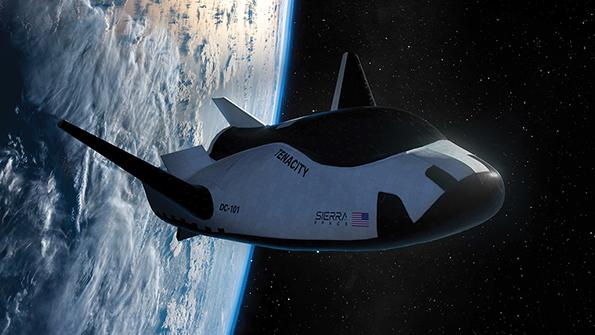
Dream Chaser concept.
COLORADO SPRINGS—Despite potential delays to United Launch Alliance’s (ULA) Vulcan Centaur launch schedule, Sierra Space says preparations continue for lofting the Dream Chaser spaceplane on its debut space mission by year’s end.
The first Dream Chaser, DC-101 Tenacity, is set to launch on the second flight of the Vulcan Centaur. Originally scheduled for the third quarter of this year, the window for this mission is currently set for December, Sierra Space CEO Tom Vice says.
ULA has been investigating the source of a hydrogen leak that damaged a Centaur V upper stage test article and its rig during structural qualification testing on March 29 at NASA’s Marshall Space Flight Center. The sudden hydrogen combustion event caused an overpressurization that ruptured the Centaur V forward dome. Despite the incident, ULA is hopeful the delay to the first Vulcan Centaur launch, originally targeted for May 4, will not be extensive.
“I think ULA will get through that quickly. They’ll isolate what happened and get that turned around,” says Vice, who also concedes that “there will be some delay associated with that, but they’ll figure it out.” Sierra is currently targeting a December launch window. But “if they need more time, we will be ready whenever we’re ready,” he adds.
Work on DC-101, as well as the follow-on Dream Chaser “Tail 2” and two cargo modules that will accompany each vehicle to orbit, continues at Sierra’s Louisville, Colorado facility. “The place is quite a beehive,” says Vice, who spoke to Aviation Week at this week’s Space Symposium here. “The next big milestone for us is to go through power-on for Dream Chaser. We’ve already powered on the cargo module. Then we just shake it out in the factory and take it through a battery of tests before we shrink wrap it and get it to Neil Armstrong Test Facility, Sandusky, Ohio, in July,” he adds.
Once in Ohio, Sierra plans three main test phases, including evaluations in a thermal vacuum chamber plus acoustic and vibration tests. “Then right now the plan is to get the vehicle to Kennedy Space Center in the beginning of the first week of November,” Vice says. “Then we will get married up with Vulcan and get into a series of integration tests before going into space when the thing is ready.”
Design work on the optionally crewed/cargo next-generation Dream Chaser DC-200 version also continues based on lessons learned from the DC-100 generation. “We’re very focused on getting our crewed variant up and operational, and we’d love to sell crewed missions to NASA as well,” says Vice, who says the new spaceplane is provisionally set for first flight in late 2026.
Aimed at being less costly and quicker to market than its forebear, the DC-200 will be 40% larger and a winged spaceplane rather than another lifting body. “We’ve got better aerodynamics, its more efficient and we are thinking differently about areas such as the utilization of thermal protection systems. So there’s lots of new improvements that we’re going to take advantage of those, but we’re also not going to try to do something that’s going to take us 10 years to design either,” Vice says.
Although Sierra originally hoped to reach the preliminary design review (PDR) stage at the end of the year, Vice says the company has opted to focus on additional trade studies before closing on this phase. “I’d really like to take the time now to conduct these trades rather than try to rush to PDR just for PDR’s sake. Right now, I would say the PDR won’t be any later than May or June 2024. I also want to get more of the critical safety stuff done first. Usually, you wait a little after PDR to get to the safety-critical items. I want to get some of that locked down now,” he adds.





